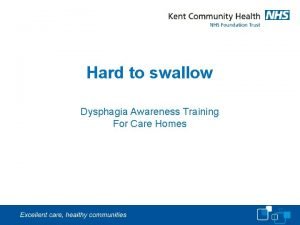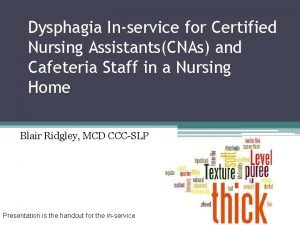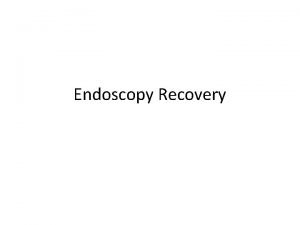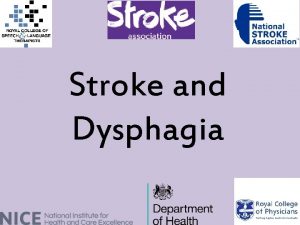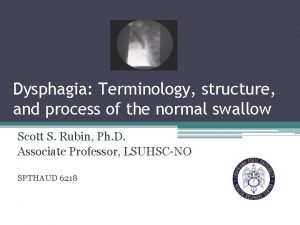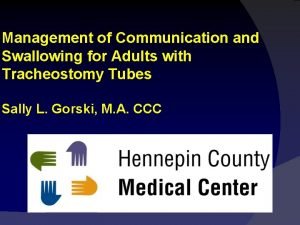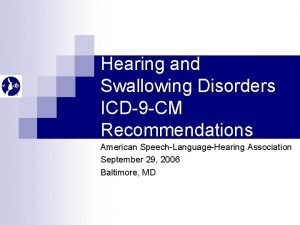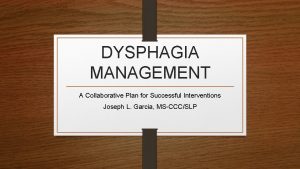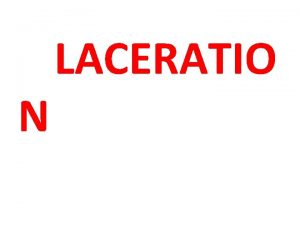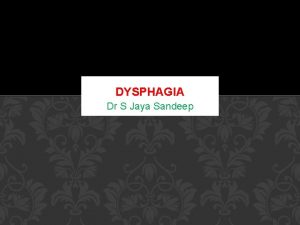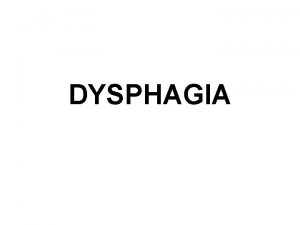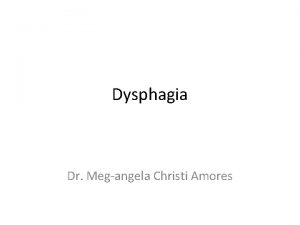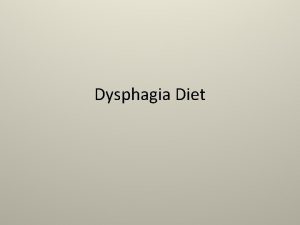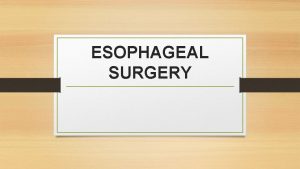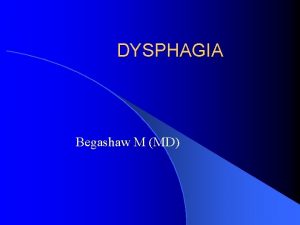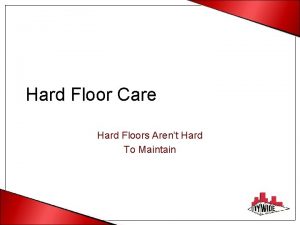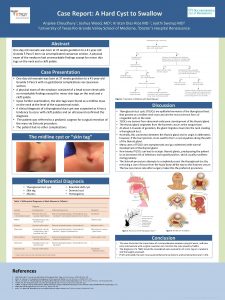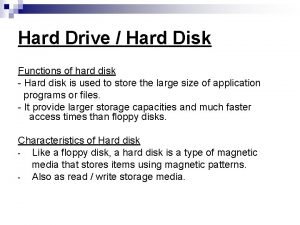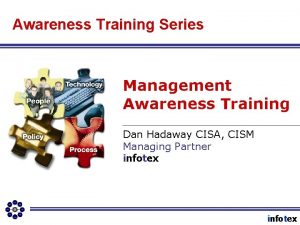Hard to swallow Dysphagia Awareness Training For Care





























- Slides: 29

Hard to swallow Dysphagia Awareness Training For Care Homes

Course objectives By the end of this workshop, you will: • • Have an understanding of dysphagia, what can cause it and what the risks are Be able to identify when someone has a swallowing problem and know what first actions to take Know when and how to refer to SLT Be able to support a resident with dysphagia to eat and drink as safely and comfortably as possible.

CQC requirements & dysphagia Some of the CQC regulations that are relevant for dysphagia: • • • Supporting residents to eat and drink enough and maintain a balanced healthy diet Coordination of care with other professionals such as SLT and Dietetics Identifying needs and risks around swallowing Supporting people in a sensitive manner to meet their nutritional requirements, taking the resident’s own views and wishes into account Effective care based on best practice from staff who have the knowledge and skills to carry out their roles and responsibilities

Normal swallowing vs. dysphagia Dysphagia = a disorder of swallowing Swallowing is the movement of food, drink and saliva from our mouth to our stomach without letting it enter our airway Normal swallowing is a complex process that we do around 1500 times per day, even when we’re asleep Swallowing is partly under our control and partly a reflex For this workshop we are talking about ‘oropharyngeal dysphagia’ – this is the part of the swallowing process that SLTs are expert in and can assess and advise on Animation clip of normal swallowing: https: //www. youtube. com/watch? v=e. Lvfzy. ZNn. Vw

Understanding dysphagia What can go wrong with swallowing? Anything! The swallow can break down anywhere and usually in more than one part of the process Dysphagia can present in many ways. It can be: • Transient (short term) • Fluctuating (better and worse at different times) • Persistent/chronic (long term) • Deteriorating (gradually getting worse)

What else can make swallowing more difficult? • • Feeling drowsy or less alert Reclined or lying down Distracted Talking while food is in the mouth Partial / no dentition, loose dentures, dentures not in Over filling your mouth Eating too fast If any of these things are difficult, then the risk of unsafe swallowing is higher.

Dysphagia – what are the risks? • Aspiration • Small amounts of food/drink/meds go into airway and lungs instead of oesophagus (food pipe) + stomach • Can be noisy with coughing, or sometimes silent (no coughing) • Can cause chest infections and pneumonia. • Choking • Airway is blocked with solid food, risk of sudden death. • Inadequate nutrition and/or hydration • Harder to eat and drink enough, sometimes reluctance to eat or drink. • Social and emotional impact – embarrassment, less involved in social meals, drinks etc, less enjoyment of food & drink, impact on choice and independence, anxiety and distress.

Dysphagia: identification What are the signs and symptoms of dysphagia? • Coughing/spluttering on food/drink • Choking • Drooling • Wet gurgly voice, especially after food/drink • Frequent chest infections/aspiration pneumonia • Pocketing food, residue in mouth • Holding food in mouth for long periods • Person complains of difficulty • Complains of food getting stuck going down (* NB this often suggests a difficulty lower down, in the oesophagus/food pipe) Less likely: refusing food/drink, pain on swallowing, reduced appetite

Identifying a swallowing problem – first steps • • Observe and document any difficulties – is there a pattern? Check if there is any history of dysphagia Has the resident seen SLT before? What were the most recent SLT recommendations? Check that the resident is on the correct diet and fluids as recommended by SLT Put in place extra measures to make swallowing as safe as possible Monitor closely and document your observations Think about whether you need to make a referral to SLT for a full specialist assessment of swallowing

When a resident needs help with feeding • The way we eat and drink is very individual • Temperature – lukewarm tea, anyone? • Meat first, then veg – or a little bit of everything on the fork? • Custard on everything, by the side or not at all? • Small sips or big gulps? • When we need someone to feed us, we lose that control • How would that feel?

Top tips for safer swallowing (1) Make sure that: • The person is fully alert and awake for anything that they need to swallow (food, drinks or medication) • The person is sitting as upright as possible with their chin slightly down • You have checked that the most recent SLT swallowing advice for this resident is being followed • Help is available for the person to feed themselves. Encourage the person to concentrate and not to talk while they are eating

Top tips for safer swallowing cont’d (2) Make sure that: • Mouthfuls or sips are not too big. • Eating and drinking is at a steady rate and not too fast. Watch for a swallow and a clear mouth before the next spoonful or sip is taken (These last two things are much harder if someone else is feeding you) • Check that utensils are really needed • Check that their mouth is clear after each meal • Good oral hygiene is maintained by regular mouth care.

Risk factors to be aware of If you are aware of these things, it could make a difference Level of learning disability/cognitive function Rapid decline in function due to ill health (decompensation) Behavioural difficulties How you manage the care environment and support could make a difference Physical environment Social environment Access to specialised equipment Staffing level Staff adherence to a plan Quality of life/loss of dignity Choosing the right moment could make a difference Alertness/cooperation Distractibility Fatigue Supporting someone’s general health could make a difference Seizure activity Oral health problems Underlying respiratory problem Posture control Unmanaged pain Mental health problems Medication Injury/discomfort

When to refer to SLT • • • If there are signs of a new swallowing difficulty or if swallowing problems have got worse If the problem seems to be at the mouth and throat level (oropharyngeal) and not lower down (oesophageal) If you have not been able to manage the swallowing difficulty by putting in place basic safer swallow measures, eg. making sure that they are alert and upright. NB If the person has been seen by SLT in the past and has a plan in place for eating and drinking at risk, then discuss with SLT before re-referring.

If the person also has a learning disability you can also refer • • • To screen the person for swallowing difficulty – ‘just to check’ Refusing to eat/drink – this usually relates to appetite or cognition and not swallowing Too drowsy/unwell to eat/drink Pain on swallowing – needs examination by doctor Vomiting/regurgitating/food sticking at oesophageal level See SLT handout “Swallowing Difficulties or Dysphagia in Care Homes” for more information

How to refer to Adult SLT 1. Complete our referral form with as much relevant information as possible 2. Send via secure email to our central point of access: kentchft. aslt@nhs. net We cover these areas: • Ashford & South Kent Coast • Canterbury & Coast • Thanet • West Kent We will then process the referral by triaging and prioritising by clinical risk and referral date.

How to refer to LD SLT Complete our referral form with as much relevant information as possible. You can do this on paper, or fill in the online version by visiting the learning disability KCHFT website pages. or call us if you have any queries or urgent concerns. Send the forms to our central point of access: kentchft. ldsref@nhs. net or snail mail to the address at the top of the form. We cover these areas: • Ashford Canterbury and Coastal • South Kent Coast and Thanet • Dartford, Gravesham, Swanley and Swale • West Kent 1.

Managing dysphagia We aim to: • Maximise health and well-being • Minimise risk of aspiration and choking • Minimise risk of under-nutrition or dehydration • Keep someone eating and drinking for as long as possible with as few restrictions as possible • Give clear information to the patient, family/carers and other health professionals about the swallowing problem Sometimes dysphagia can be treated and swallowing can be improved, eg after a stroke. Often it is not possible to make the problem better and so we manage it as best we can to achieve the above aims.

Managing dysphagia This could be through: • Thickened fluids • Modified diets / alternative feeding • Positioning • Rate of feeding • Bolus size • Special equipment • Mouthcare • • • Suggesting changes to medication Assistance to eat and drink Supervision Adjusting help according to changes in the person’s condition Monitoring

The way that Speech and Language Therapists (SLTs) and other professionals describe dysphagia diets and thickened drinks is changing across the UK and the world.



Thickened fluids Thin fluids Slightly thick fluids Mildly thick fluids Moderately thick Extremely thick

How to thicken drinks 1. Add the recommended number of flat scoops of Resource Thicken Up Clear™ to a dry empty cup/glass No. of level scoops: mildly= 2 moderately=4 extremely=8 per 200 mls 2. Pour in 200 mls of your chosen drink 3. Immediately stir briskly with a spoon until the powder is dissolved 4. Leave to stand for 2 minutes until the drink has thickened 5. Check consistency is correct - if it is not right you will have to pour the drink away and start again

Top tips for thickening drinks The drink should be thickened by staff before it is given to the patient or left on their table – to avoid aspiration if it is drunk unthickened All liquids should be thickened (unless specified in SLT recommendations) – ie. all cold and hot drinks, fizzy drinks, soups, nutritional supplement drinks, gravy, alcoholic drinks etc Be positive about the drink if you are preparing it for someone Some people find cold thickened drinks more enjoyable, or drinks with a stronger flavour, eg. squash rather than water If the patient has any liquid or soluble medications, discuss with the pharmacist and make your SLT aware. NB. DO NOT leave the tub of thickener within reach of the patient, as this is a choking risk if ingested accidentally

Cups, spouts and straws • • Spouts don’t let you control how fast the drink comes into your mouth Wide spouts are particularly difficult Spouts also encourage you to tip your head back, which is a bigger risk for the fluid going down too fast and into the airway Straws are helpful for some people, but others find them hard to control Straws can direct the drink towards the back of the mouth and it might go down into the throat too quickly If possible, normal cups are often best for swallowing, because your head comes forwards and your lips can control the flow of drink Other options include: • Nosey beakers, dysphagia cups • Controlled bolus cups • Steady hands cups

The importance of mouthcare Why is good oral hygiene so important in the care of patients with dysphagia? • • • They are more likely to get food residue in the mouth Eating and drinking may already be less enjoyable – without a clean mouth even more so Poor oral hygiene means more bacteria in the mouth Any food, fluid or saliva which is aspirated will transport those bacteria into the airway and the lungs This greatly increases their chance of developing aspiration pneumonia

Mouth care guidance for care homes - NICE has some good clear guidance for care homes about mouth care and how to improve oral hygiene https: //www. nice. org. uk/about/nice-communities/social-care/quickguides/improving-oral-health-for-adults-in-care-homes This is a good booklet: https: //www. nice. org. uk/Media/Default/Oral_health_quick_guide/Oral_health_a_ quick_guide_for_care_home_managers. pdf

Thank you for listening and participating today, we hope it has been helpful. Any questions?
 Symptoms of dysphagia
Symptoms of dysphagia Privacy awareness and hipaa privacy training cvs answers
Privacy awareness and hipaa privacy training cvs answers Levels of health care primary secondary tertiary
Levels of health care primary secondary tertiary Gravimetric analysis of calcium and hard water lab answers
Gravimetric analysis of calcium and hard water lab answers Work hard have fun make history
Work hard have fun make history Hard times hard drive
Hard times hard drive Cause dysphagia
Cause dysphagia Odynophagia vs dysphagia
Odynophagia vs dysphagia Dysphagia diet levels handout
Dysphagia diet levels handout Dysphagia lusoria
Dysphagia lusoria Differential diagnosis for dysphagia
Differential diagnosis for dysphagia Maroon spoon dysphagia
Maroon spoon dysphagia Dysphagia grading
Dysphagia grading Pediatric dysphagia resource guide
Pediatric dysphagia resource guide Edinburgh dysphagia score
Edinburgh dysphagia score Dysphagia management market
Dysphagia management market Nice stroke pathway
Nice stroke pathway Minor salivary glands
Minor salivary glands Frazier free water protocol
Frazier free water protocol Differential diagnosis of dysphagia
Differential diagnosis of dysphagia Dysphagia
Dysphagia Symptoms of dysphagia
Symptoms of dysphagia Phases of swallowing
Phases of swallowing Dysphagia management plan
Dysphagia management plan Gastric ulcer barium swallow
Gastric ulcer barium swallow Gag swallow reflexes
Gag swallow reflexes Puberphonia
Puberphonia Trifoliate deformity duodenal ulcer
Trifoliate deformity duodenal ulcer Swallow tail in laceration
Swallow tail in laceration What is a shake hole on a map
What is a shake hole on a map
